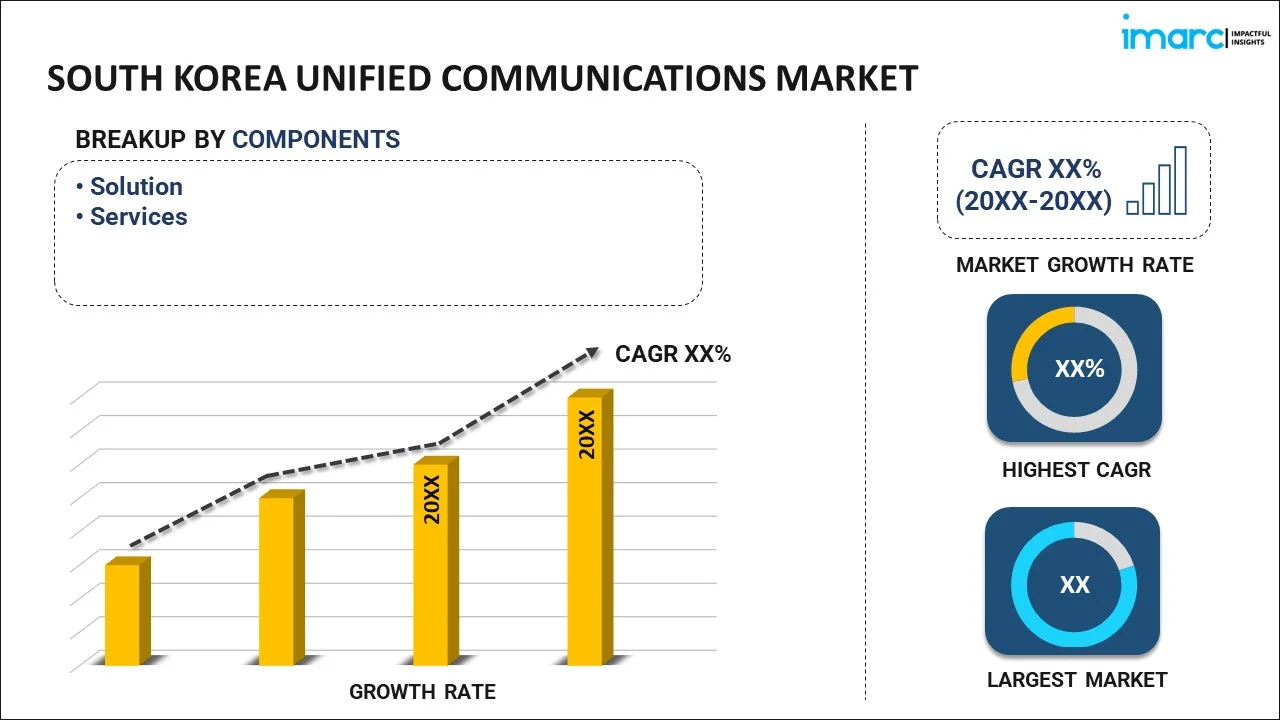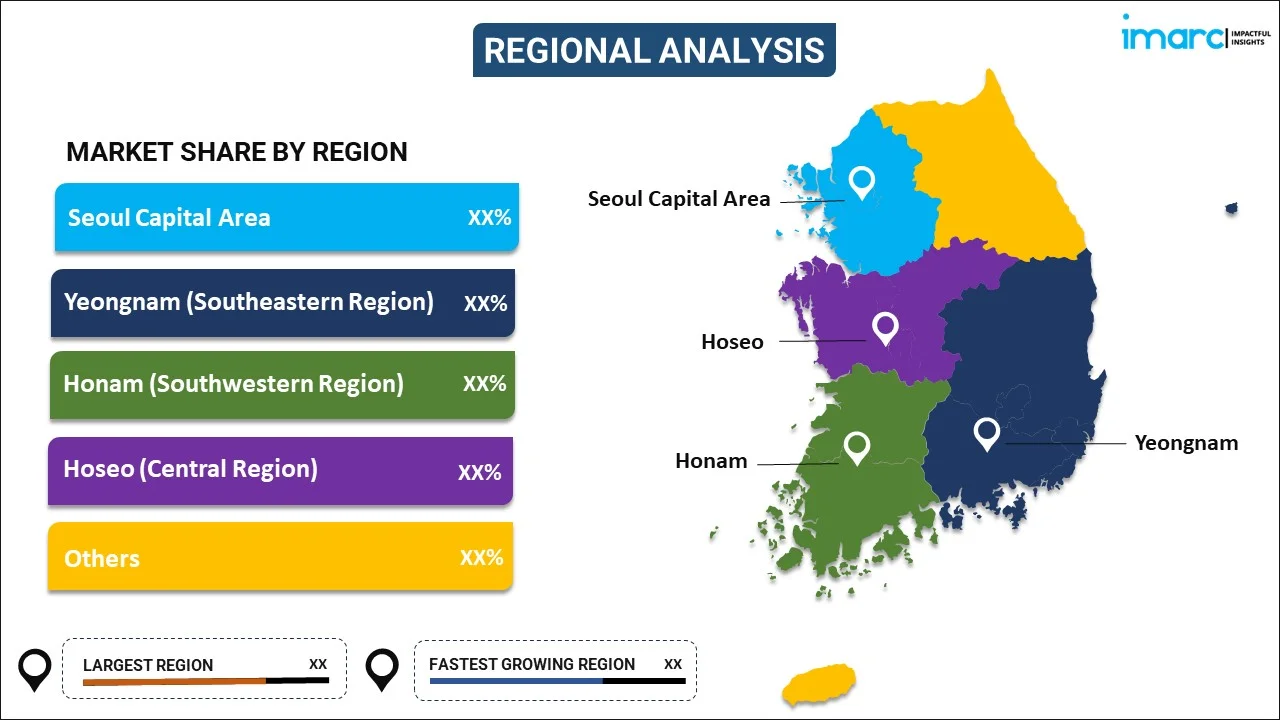
South Korea Unified Communications Market Report by Component (Solution, Services), Deployment Mode (On-premises, Hosted), Organization Size (Small and Medium-sized Enterprises, Large Enterprises), End User (Enterprises, Education, Government, Healthcare, and Others), and Region 2025-2033
Market Overview:
South Korea unified communications market size reached USD 2.8 Billion in 2024. Looking forward, IMARC Group expects the market to reach USD 10.8 Billion by 2033, exhibiting a growth rate (CAGR) of 14.5% during 2025-2033. The widespread adoption of cloud services, as they provide several benefits, including scalability, flexibility, cost-effectiveness, etc., is primarily driving the regional market.
|
Report Attribute
|
Key Statistics
|
|---|---|
|
Base Year
|
2024 |
|
Forecast Years
|
2025-2033
|
|
Historical Years
|
2019-2024
|
| Market Size in 2024 | USD 2.8 Billion |
| Market Forecast in 2033 | USD 10.8 Billion |
| Market Growth Rate (2025-2033) | 14.5% |
Unified communications (UC) is a concept that revolves around consolidating various communication channels, tools, and technologies into a singular platform. These platforms ensure users experience a seamless, uniform, and all-encompassing communication environment, irrespective of their location or device. The primary goal is to enhance communication and collaboration among employees, customers, and partners, leading to heightened productivity, efficiency, and innovation. A typical UC solution comprises fundamental elements such as voice, video, messaging, presence, and collaboration tools. Voice communication is commonly facilitated through voice over IP (VoIP) technology, enabling the transmission of voice calls over the internet rather than traditional phone lines. Video communication enables virtual meetings, conferences, and webinars, incorporating features like screen sharing, whiteboarding, and document sharing.
South Korea Unified Communications Market Trends:
The South Korea unified communications market stands as a beacon of technological integration, seamlessly bringing together diverse communication channels, tools, and technologies onto a unified platform. This innovative concept ensures users enjoy a consistent and comprehensive communication experience, regardless of their location or the devices they use. The overarching objective of unified communications solutions in South Korea is to elevate communication and collaboration among employees, customers, and partners, fostering increased productivity, operational efficiency, and a culture of innovation. Additionally, voice communication employs advanced voice over IP (VoIP) technology, facilitating internet-based voice calls instead of traditional telephone lines. A significant advantage of UC solutions lies in their ability to deliver cost savings by consolidating multiple communication tools and services. By unifying communication infrastructure, businesses in South Korea can streamline operations, reduce maintenance costs, and simplify billing processes. Furthermore, the integration of UC platforms with other business applications, including customer relationship management (CRM) systems, creates a holistic and unified view of customer interactions, enhancing customer engagement. As South Korea continues to emphasize technological advancement, the unified communications market will play a pivotal role in driving efficiency, connectivity, and collaboration across various industries in the coming years.
South Korea Unified Communications Market Segmentation:
IMARC Group provides an analysis of the key trends in each segment of the market, along with forecasts at the country level for 2025-2033. Our report has categorized the market based on component, deployment mode, organization size, and end user.
Component Insights:

- Solution
- Instant and Unified Messaging
- Audio and Video Conferencing
- IP Telephony
- Others
- Services
- Professional Services
- Managed Services
The report has provided a detailed breakup and analysis of the market based on the component. This includes solution (instant and unified messaging, audio and video conferencing, IP telephony, and others) and services (professional services and managed services).
Deployment Mode Insights:
- On-premises
- Hosted
A detailed breakup and analysis of the market based on the deployment mode have also been provided in the report. This includes on-premises and hosted.
Organization Size Insights:
- Small and Medium-sized Enterprises
- Large Enterprises
The report has provided a detailed breakup and analysis of the market based on the organization size. This includes small and medium-sized enterprises and large enterprises.
End User Insights:
- Enterprises
- Education
- Government
- Healthcare
- Others
A detailed breakup and analysis of the market based on the end user have also been provided in the report. This includes enterprises, education, government, healthcare, and others.
Regional Insights:

- Seoul Capital Area
- Yeongnam (Southeastern Region)
- Honam (Southwestern Region)
- Hoseo (Central Region)
- Others
The report has also provided a comprehensive analysis of all the major regional markets, which include Seoul Capital Area, Yeongnam (Southeastern Region), Honam (Southwestern Region), Hoseo (Central Region), and Others.
Competitive Landscape:
The market research report has also provided a comprehensive analysis of the competitive landscape in the market. Competitive analysis such as market structure, key player positioning, top winning strategies, competitive dashboard, and company evaluation quadrant has been covered in the report. Also, detailed profiles of all major companies have been provided.
South Korea Unified Communications Market Report Coverage:
| Report Features | Details |
|---|---|
| Base Year of the Analysis | 2024 |
| Historical Period | 2019-2024 |
| Forecast Period | 2025-2033 |
| Units | Billion USD |
| Scope of the Report | Exploration of Historical and Forecast Trends, Industry Catalysts and Challenges, Segment-Wise Historical and Predictive Market Assessment:
|
| Components Covered |
|
| Deployment Modes Covered | On-premises, Hosted |
| Organization Sizes Covered | Small and Medium-sized Enterprises, Large Enterprises |
| End Users Covered | Enterprises, Education, Government, Healthcare, Others |
| Regions Covered | Seoul Capital Area, Yeongnam (Southeastern Region), Honam (Southwestern Region), Hoseo (Central Region), Others |
| Customization Scope | 10% Free Customization |
| Post-Sale Analyst Support | 10-12 Weeks |
| Delivery Format | PDF and Excel through Email (We can also provide the editable version of the report in PPT/Word format on special request) |
Key Questions Answered in This Report:
- How has the South Korea unified communications market performed so far and how will it perform in the coming years?
- What is the breakup of the South Korea unified communications market on the basis of component?
- What is the breakup of the South Korea unified communications market on the basis of deployment mode?
- What is the breakup of the South Korea unified communications market on the basis of organization size?
- What is the breakup of the South Korea unified communications market on the basis of end user?
- What are the various stages in the value chain of the South Korea unified communications market?
- What are the key driving factors and challenges in the South Korea unified communications?
- What is the structure of the South Korea unified communications market and who are the key players?
- What is the degree of competition in the South Korea unified communications market?
Key Benefits for Stakeholders:
- IMARC’s industry report offers a comprehensive quantitative analysis of various market segments, historical and current market trends, market forecasts, and dynamics of the South Korea unified communications market from 2019-2033.
- The research report provides the latest information on the market drivers, challenges, and opportunities in the South Korea unified communications market.
- Porter's five forces analysis assist stakeholders in assessing the impact of new entrants, competitive rivalry, supplier power, buyer power, and the threat of substitution. It helps stakeholders to analyze the level of competition within the South Korea unified communications industry and its attractiveness.
- Competitive landscape allows stakeholders to understand their competitive environment and provides an insight into the current positions of key players in the market.
Need more help?
- Speak to our experienced analysts for insights on the current market scenarios.
- Include additional segments and countries to customize the report as per your requirement.
- Gain an unparalleled competitive advantage in your domain by understanding how to utilize the report and positively impacting your operations and revenue.
- For further assistance, please connect with our analysts.
 Request Customization
Request Customization
 Speak to an Analyst
Speak to an Analyst
 Request Brochure
Request Brochure
 Inquire Before Buying
Inquire Before Buying




.webp)




.webp)












